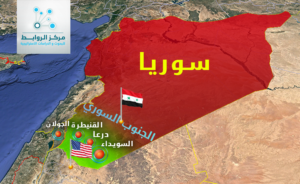On the seventh of the last July, a ceasefire agreement was announced in the south – west Syria, following a bilateral meeting at the forum of “Group of Twenty” between US President Donald Trump and his Russian counterpart Vladimir Putin. The agreement covers three provinces al-Suwayda, and Daraa, and Quneitra. These provinces represent conflicting parties include the forces of the regime backed by Iranian militias and Hezbollah fighters and factions of the Syrian armed opposition that fall under the name of the “southern front”. As for areas under control of armed opposition groups, it stretches from the east in the Golan over seventy kilometers and surrounding the city Daraa with a population of about 400 thousand people. At the same time, nearly one million people live in the territory of the Syrian regime includes Daraa and Suwayda and the city of Baath. The agreement does not include any details on the fate of this land in the long term. And the ceasefire agreement in the south of Syria constitutes an opportunity for wider cooperation between USA and Russia in Syria.
And in the context of the continuation of this agreement a number of questions are raised including: will the south-western region of Syria , in addition to the area of al-Nataf , “the Syrian ,Jordanian Iraqi triangle” see an independent administration supervised by the United Nations ? to make the popular crowd to abandon about the idea of control over the area of al-Nataf, this means that the popular crowd absorbed the military message sent by the administration of US President Donald Trump to it when the US jets targeting the Syrian regime’s military convoys and its allies from the Shiite militias at the military al-Nataf base at the Iraqi-Syrian-Jordanian border triangle for securing the border in view of what is represented by the arrival of Iranian militias of the threat to troops of opposition stationed at the base along with a group of US officers and military advisers. A few days later, US forces shot down an Iranian air armed drone that it was attacking the US fighters and other opposition forces in al-Nataf area. The incident has shown the readiness of «Quds» Brigade to confront the troops of the United States in Syria directly, as well as the readiness of the United States to respond to the new Iranian provocations in the country. On June 19, US troops were forced again to shoot down an Iranian drone near the garrison of al-Nataf.
According to military experts, the US military strike sent messages to local and regional actors showing the importance of the border areas for the US strategic thinking, which extends to the stage of post-organization Daesh in Syria and Iraq, and the process of arrangement of influence within them, and it showed how serious Washington in preventing any force working by proxy for Iran’s interest to control the border areas and points of communication between the countries of the region.
Last June , the leader of the popular crowd Abu Mahdi al-Muhandis while he was in Tal Afar said the area will be cleansed from the fighters of the terrorist Daesh and follow them everywhere down to “the Saudi capital,” Riyadh, pointing out that he is currently on the Iraqi-Syrian border, accompanied by fighters of the popular crowd. Will the Russian American agreement cut the road to the schemes of popular crowd or they are going a head in it?
And will this agreement also cut off the road to the popular crowd to enter Syrian territory controlled by Kurdish forces allied to the United States of America? According to special information obtained by Rawabet Center for Research and Strategic Studies, the United States of America has nine military bases in the Kurdish-controlled areas in Syria, and according to that information, the US fighter jets have landed in it. According to information also, the Kurdish forces had told the Iraqi popular crowd forces that in the event of a breakthrough to the Syrian border, they will be faced strongly by the American Kurdish “Syrian alliance.”
Based on the above, will the US –Russian agreement succeed in south-west Syria in the light of the failed cease-fire experiments? There are precedents that raise concern this year, the Iranian –backed Shiite militias, violated the agreements of ceasefire prepared by the Russian allies. In January 2017, for example, both the Assad regime and the militias ignored the Russian and Turkish agreement and continued to launch attacks in several areas in Syria, including Wadi Barada and Ghouta and eastern outskirts of Damascus. Then, in May, Shiite militias have violated the so-called de-escalation zone concluded between Russia, Turkey and Iran, launching attacks on the outskirts of Homs and Hama. In the same month, US air strikes have killed several members of the militia of Iraqi «popular crowd» backed by Iran, when those were advancing towards the Syrian forces, anti the terrorist-al Daesh and backed by the United States in the al-Nataf , an “prohibited” area created by Moscow and Washington. During these strikes, some reports indicated that US warplanes also targeted the Lebanese militia «Hezbollah», killing a number of elements.
The multiple forms of conflict in the Arab Mashreq establishes a conviction that Syria would be the point of redrawing its map again.
Arab Studies Unit
Rawabet Center for Research and Strategic Studies

